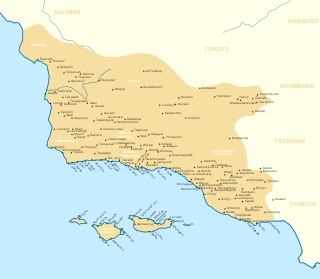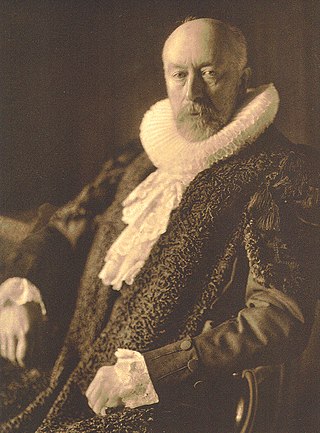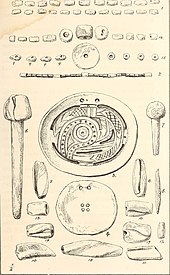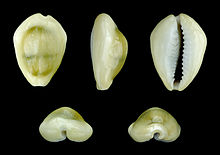
Commodity money is money whose value comes from a commodity of which it is made. Commodity money consists of objects having value or use in themselves as well as their value in buying goods. This is in contrast to representative money, which has no intrinsic value but represents something of value such as gold or silver, in which it can be exchanged, and fiat money, which derives its value from having been established as money by government regulation.

A seashell or sea shell, also known simply as a shell, is a hard, protective outer layer usually created by an animal or organism that lives in the sea. The shell is part of the body of the animal. Empty seashells are often found washed up on beaches by beachcombers. The shells are empty because the animal has died and the soft parts have decomposed or been eaten by another animal.

The Chumash are a Native American people of the central and southern coastal regions of California, in portions of what is now Kern, San Luis Obispo, Santa Barbara, Ventura and Los Angeles counties, extending from Morro Bay in the north to Malibu in the south to Mt Pinos in the east. Their territory includes three of the Channel Islands: Santa Cruz, Santa Rosa, and San Miguel; the smaller island of Anacapa was likely inhabited seasonally due to the lack of a consistent water source.

The cedi is the unit of currency of Ghana. It is the fourth historical and only current legal tender in the Republic of Ghana. One Cedi is divided into one hundred Pesewas (Gp).

Cowrie or cowry (pl. cowries) is the common name for a group of small to large sea snails, marine gastropod mollusks in the family Cypraeidae, the cowries.

Wampum is a traditional shell bead of the Eastern Woodlands tribes of Native Americans. It includes white shell beads hand-fashioned from the North Atlantic channeled whelk shell and white and purple beads made from the quahog or Western North Atlantic hard-shelled clam.

Microblade technology is a period of technological microlith development marked by the creation and use of small stone blades, which are produced by chipping silica-rich stones like chert, quartz, or obsidian. Blades are a specialized type of lithic flake that are at least twice as long as they are wide. An alternate method of defining blades focuses on production features, including parallel lateral edges and dorsal scars, a lack of cortex, a prepared platform with a broad angle, and a proximal bulb of percussion. Microblades are generally less than 50 mm long in their finished state.
The history of money is the development over time of systems for the exchange, storage, and measurement of wealth. Money is a means of fulfilling these functions indirectly and in general rather than directly, as with barter.

Cypraeidae, commonly named the cowries, is a taxonomic family of small to large sea snails. These are marine gastropod mollusks in the superfamily Cypraeoidea, the cowries and cowry allies.

The Awaswas, also known as the Santa Cruz people, were a group of the Indigenous peoples of California in North America, with subgroups historically numbering about 600 to 1,400. Academic research suggests that their ancestors had lived within the Santa Cruz Mountains region for approximately 12,000 years. The Awaswas maintained regular trade networks with regional cultures before the Spanish colonists began settling in the area from the 18th century.

Money is any item or verifiable record that is generally accepted as payment for goods and services and repayment of debts, such as taxes, in a particular country or socio-economic context. The primary functions which distinguish money are: medium of exchange, a unit of account, a store of value and sometimes, a standard of deferred payment.

Manillas are a form of commodity money, usually made of bronze or copper, which were used in West Africa. They were produced in large numbers in a wide range of designs, sizes, and weights. Originating before the colonial period, perhaps as the result of trade with the Portuguese Empire, manillas continued to serve as money and decorative objects until the late 1940s and are still sometimes used as decoration on arms, legs and around the neck. In popular culture, they are particularly associated with the Atlantic slave trade.
The word dentalium, as commonly used by Native American artists and anthropologists, refers to tooth shells or tusk shells used in indigenous jewelry, adornment, and commerce in western Canada and the United States. These tusk shells are a kind of seashell, specifically the shells of scaphopod mollusks. The name "dentalium" is based on the scientific name for the genus Dentalium, but because the taxonomy has changed over time, not all of the species used are still placed in that genus; however, all of the species are certainly in the family Dentaliidae.

Monetaria moneta, common name the money cowrie, is a species of small sea snail, a marine gastropod mollusk in the family Cypraeidae, the cowries.

A tomol or tomolo (Chumash) or te'aat or ti'at (Tongva/Kizh) are plank-built boats, historically and currently in the Santa Barbara, California and Los Angeles area. They replaced or supplemented tule reed boats. The boats were between 10–30 feet (3.0–9.1 m) in length and 3–4 feet (0.91–1.22 m) in width. The Chumash refer to the tomol as the "House of the Sea" for their reliability. Double-bladed kayak-like paddles are used to propel the boat through the ocean. Some sources suggest the boats may have origins at Catalina Island and have been in use for thousands of years. Others suggest an origin on the Northern Channel Islands during the first millennium CE.The tomol has been described as "the single most technologically complex watercraft built in North America" and as being unique to "the New World."

Callianax biplicata, common names the purple dwarf olive, purple olive shell, or purple olivella is a species of small predatory sea snail, a marine gastropod mollusc in the family Olividae, the olives.

Monetaria annulus, common name the ring cowrie, ring top cowrie, or gold ring cowrie, is a species of sea snail, a cowry, a marine gastropod mollusk in the family Cypraeidae, the cowries.

William Henry O'Swald was a Hamburg overseas merchant and Senator.

Molluscs play a variety of roles in culture, including but not limited to art and literature, with both practical interactions—whether useful or harmful—and symbolic uses.
Humaliwo was a Chumash village located in present-day Malibu, California. “Humaliwo” meant "where the surf sounds loudly." The village occupied a hill across from the lagoon in Malibu Lagoon State Beach. The neighboring Tongva referred to the village as Ongobehangna. The Humaliwo village was recorded on the National Register of Historic Places (NRHP) in 1976. Cultural remains are present at this site, consisting of numerous human burials, artifacts and other cultural materials. Sections of the site can be dated to 7,000 years old.























